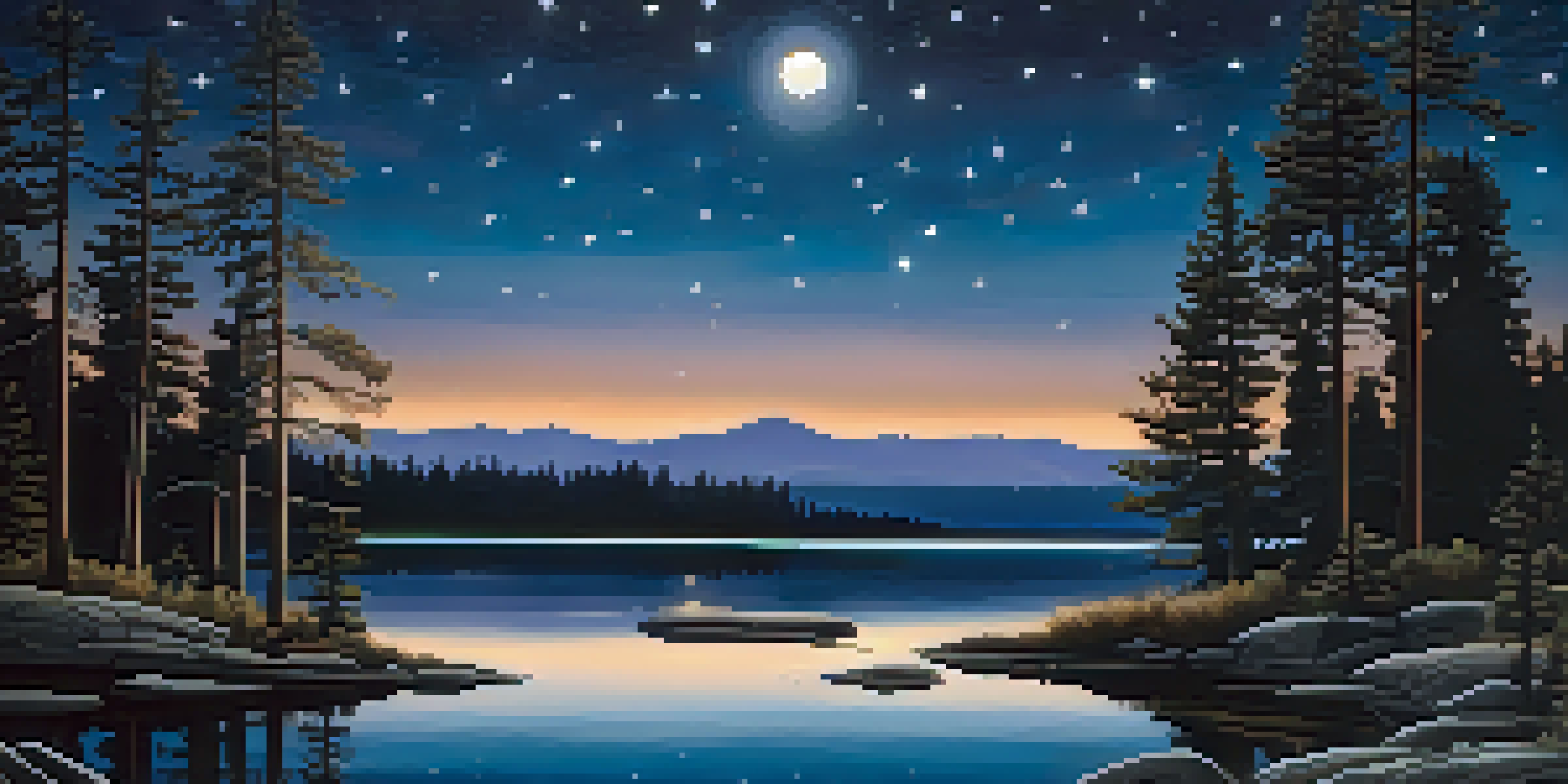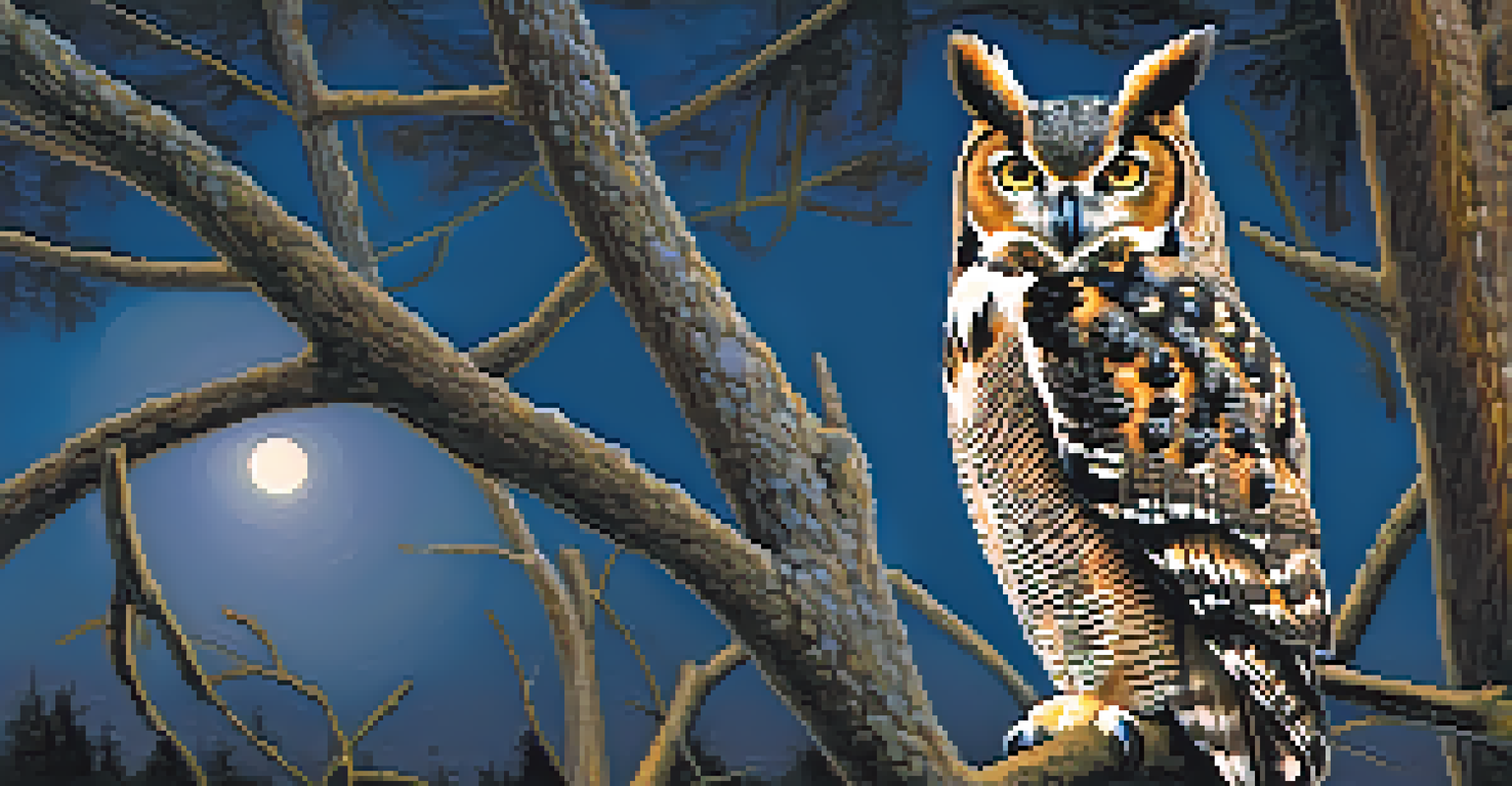Nighttime Wildlife in Big Bear: Creatures of the Dark

The Magic of Big Bear After Sunset
When the sun dips below the horizon in Big Bear, the landscape transforms into a hub of nocturnal activity. The peaceful silence of the day gives way to the rustle of leaves and the calls of wildlife that thrive in the dark. For those willing to explore, the night reveals a captivating world just waiting to be discovered.
In every walk with nature, one receives far more than he seeks.
As the stars twinkle above, many animals come to life, showcasing their unique behaviors that are often hidden during daylight hours. From the chirping of crickets to the hooting of owls, the symphony of sounds paints a vivid picture of life in the shadows. It's a reminder that the night is not just a time for rest but a vibrant period of activity for many creatures.
Venturing out at night allows visitors to witness the fascinating adaptations of wildlife, such as enhanced eyesight and heightened senses. This enchanting experience not only deepens our appreciation for nature but also offers a chance to connect with the wilderness in a whole new way.
Meet the Nocturnal Stars: Owls of Big Bear
Owls are among the most iconic nocturnal animals in Big Bear, and for good reason. With their large, expressive eyes and unique ability to rotate their heads almost completely, owls capture the imagination of anyone lucky enough to spot them. These skilled hunters are perfectly adapted to life after dark, using their exceptional hearing and silent flight to catch prey.

The Great Horned Owl and Barn Owl are two species commonly found in the area, each with distinct calls and characteristics. The Great Horned Owl boasts tufted 'ears' and a deep, resonating hoot, while the Barn Owl is known for its ghostly appearance and eerie screech. Observing these magnificent birds in their natural habitat is a thrilling experience that highlights the beauty of nighttime wildlife.
Explore Big Bear's Nocturnal Life
The night in Big Bear unveils a vibrant ecosystem alive with wildlife, showcasing unique behaviors often hidden during the day.
Owls play a crucial role in the ecosystem, helping to control rodent populations and maintaining a balance in the food chain. Their presence in Big Bear is a testament to the health of the surrounding environment and serves as a reminder of the importance of conservation efforts in preserving these majestic creatures.
Cunning Predators: Coyotes on the Prowl
Coyotes are another fascinating aspect of Big Bear's nighttime wildlife. These adaptable predators are known for their intelligence and vocalizations, which can often be heard echoing through the mountains. With their keen senses and social structure, coyotes thrive in the diverse habitats of Big Bear, making them a common sight after sunset.
The clearest way into the Universe is through a forest wilderness.
Unlike their more solitary relatives, wolves, coyotes often hunt in packs, which allows them to take down larger prey. Their cunning nature and resourcefulness enable them to thrive in various environments, from forests to urban areas. Observing a pack of coyotes in action can be a thrilling experience, showcasing their communication and teamwork.
While coyotes are often seen as a nuisance, they play an essential role in maintaining the ecosystem. By controlling populations of smaller mammals, they help keep the balance of nature intact, reminding us of the interconnectedness of wildlife in Big Bear.
Mysterious Creatures: The Nighttime Raccoons
Raccoons are perhaps the most mischievous of Big Bear's nighttime inhabitants. With their masked faces and nimble paws, these creatures are known for their intelligence and curiosity. Often found rummaging through trash or exploring campgrounds, raccoons have adapted well to living near human activity, making them a common sight at night.
Their dexterous front paws allow them to open containers and manipulate objects, showcasing their problem-solving abilities. This cleverness, coupled with their nocturnal lifestyle, makes observing raccoons a delightful experience. Many visitors find themselves chuckling at the antics of these playful bandits as they scurry about under the cover of darkness.
Meet Big Bear's Iconic Owls
Owls, such as the Great Horned and Barn Owl, are essential nocturnal hunters that play a critical role in maintaining ecological balance.
Raccoons play a significant role in their ecosystem by helping to disperse seeds and control insect populations. While they may be seen as pests at times, their presence in Big Bear contributes to the rich tapestry of wildlife that thrives in the area.
The Silent Stalkers: Big Bear's Foxes
Foxes, particularly the elusive red fox, are a sight to behold in the moonlit woods of Big Bear. Known for their slender bodies and bushy tails, these cunning hunters are well-adapted to their environment. Their stealth and agility allow them to navigate through the underbrush, making them expert hunters of small mammals and birds.
At night, the red fox's coat takes on a beautiful sheen under the moonlight, and their sharp hearing enables them to detect even the faintest sounds of rustling prey. Their playful nature often leads to fascinating displays of agility and speed, captivating anyone lucky enough to observe them in action. They embody the spirit of wilderness, embodying both grace and cunning.
Foxes also play a vital role in the ecosystem, helping to control rodent populations and maintain a balance within the food web. Their presence in Big Bear serves as a reminder of the rich biodiversity that thrives in this stunning mountain region.
Insect Symphony: The Nighttime Buzz
As the sun sets, a symphony of insects begins to fill the air, creating a unique atmosphere in Big Bear. From the gentle hum of crickets to the melodic chirping of katydids, these tiny creatures contribute to the vibrant nightlife. Their sounds not only provide a backdrop for the nocturnal landscape, but they also play a crucial role in the ecosystem.
Insects are essential for pollination, and many species are active at night, helping to sustain the delicate balance of plant life. Moths, in particular, are drawn to light and play a vital role in pollinating nocturnal flowers, showcasing the interconnectedness of wildlife. Observing these insects in action can deepen our understanding of their importance in the natural world.
Conservation for Future Generations
Supporting conservation efforts is vital to protect Big Bear's nighttime wildlife and ensure the sustainability of their habitats.
Whether you're camping under the stars or taking a quiet stroll, the nighttime insect concert adds to the overall experience of being in Big Bear. It serves as a reminder that even the smallest creatures play a significant role in the tapestry of life.
Tips for Nighttime Wildlife Watching
If you're eager to experience the nighttime wildlife of Big Bear, a few simple tips can enhance your adventure. First, consider bringing a flashlight with a red filter, which is less disturbing to wildlife and allows for better night vision. Secondly, approaching quietly and patiently will increase your chances of spotting elusive creatures like owls or foxes.
Timing is also key; dusk and dawn are often the best times to witness wildlife activity. Additionally, understanding the behaviors and habitats of the animals you hope to observe can make your experience more rewarding. For instance, knowing where coyotes are likely to roam can help you plan your excursion accordingly.

Lastly, respect the natural environment and maintain a safe distance from the animals you encounter. Observing wildlife is a privilege, and ensuring their safety and comfort should always be a priority. With these tips in mind, you're sure to create unforgettable memories of Big Bear's enchanting nighttime wildlife.
Conservation: Protecting Big Bear's Nightlife
As we marvel at the nighttime wildlife of Big Bear, it's essential to consider the impact of our actions on their habitats. Conservation efforts play a crucial role in preserving the delicate balance of ecosystems, ensuring that future generations can enjoy the same experiences. Supporting local initiatives and practicing responsible tourism can make a significant difference.
By remaining mindful of our surroundings and minimizing our impact, we can help protect the homes of these nocturnal creatures. Simple actions, such as keeping a safe distance, not feeding wildlife, and cleaning up after ourselves, contribute to the conservation of their natural habitats. Every small effort counts in sustaining the vibrant wildlife that calls Big Bear home.
Ultimately, fostering a sense of stewardship for the environment encourages a deeper appreciation of the wonders of nature. By protecting Big Bear's nighttime wildlife, we not only safeguard the beauty of our surroundings but also enrich our own experiences in this majestic mountain landscape.